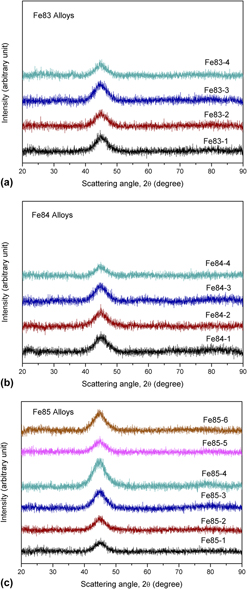Crossref Citations
This article has been cited by the following publications. This list is generated based on data provided by
Crossref.
Han, Ye
Kong, Fanli
Chang, Chuntao
Zhu, Shengli
Ketov, Sergey
Louzguine, Dmitri
and
Inoue, Akinisa
2015.
Syntheses and Fundamental Properties of Fe-rich Metastable Phase Alloys with Saturation Magnetization Exceeding 1.9 T.
Materials Research,
Vol. 18,
Issue. suppl 1,
p.
127.
Li, Y. J.
Wang, Y. G.
An, B.
Xu, H.
Liu, Y.
Zhang, L. C.
Ma, H. Y.
Wang, W. M.
and
Senko, John M.
2016.
A Practical Anodic and Cathodic Curve Intersection Model to Understand Multiple Corrosion Potentials of Fe-Based Glassy Alloys in OH- Contained Solutions.
PLOS ONE,
Vol. 11,
Issue. 1,
p.
e0146421.
Han, Y.
Kong, F.L.
Han, F.F.
Inoue, A.
Zhu, S.L.
Shalaan, E.
and
Al-Marzouki, F.
2016.
New Fe-based soft magnetic amorphous alloys with high saturation magnetization and good corrosion resistance for dust core application.
Intermetallics,
Vol. 76,
Issue. ,
p.
18.
Han, Y.
Inoue, A.
Kong, F.L.
Chang, C.T.
Shu, S.L.
Shalaan, E.
and
Al-Marzouki, F.
2016.
Softening and good ductility for nanocrystal-dispersed amorphous Fe–Co–B alloys with high saturation magnetization above 1.7 T.
Journal of Alloys and Compounds,
Vol. 657,
Issue. ,
p.
237.
Ding, Jian
Han, Ye
Kong, Fanli
Inoue, Akihisa
and
Zhu, Shengli
2016.
Syntheses and Fundamental Properties of Cr/Mo-Adoped Fe-Rich Alloys With Metastable Phase and Saturation Magnetization Near 1.9 T.
Materials Research,
Vol. 19,
Issue. 6,
p.
1299.
Han, Y.
Ding, J.
Kong, F.L.
Inoue, A.
Zhu, S.L.
Wang, Z.
Shalaan, E.
and
Al-Marzouki, F.
2017.
FeCo-based soft magnetic alloys with high Bs approaching 1.75 T and good bending ductility.
Journal of Alloys and Compounds,
Vol. 691,
Issue. ,
p.
364.
Wang, F.
Inoue, A.
Han, Y.
Zhu, S.L.
Kong, F.L.
Zanaeva, E.
Liu, G.D.
Shalaan, E.
Al-Marzouki, F.
and
Obaid, A.
2017.
Soft magnetic Fe-Co-based amorphous alloys with extremely high saturation magnetization exceeding 1.9 T and low coercivity of 2 A/m.
Journal of Alloys and Compounds,
Vol. 723,
Issue. ,
p.
376.
Kong, F.L.
Han, Y.
Wang, X.H.
Han, F.F.
Zhu, S.L.
and
Inoue, A.
2017.
SENNTIX-type amorphous alloys with high Bs and improved corrosion resistance.
Journal of Alloys and Compounds,
Vol. 707,
Issue. ,
p.
195.
Wang, D.
Ma, L.
Li, L.
Xu, X. L.
Guo, Y. B.
and
Zhao, S. Q.
2018.
Characterization of Polycrystalline Fe2B Compound with High Saturation Magnetization.
Journal of Superconductivity and Novel Magnetism,
Vol. 31,
Issue. 2,
p.
431.
Dong, C.
Inoue, A.
Wang, X.H.
Kong, F.L.
Zanaeva, E.N.
Wang, F.
Bazlov, A.I.
Zhu, S.L.
and
Li, Q.
2018.
Soft magnetic properties of Fe82-83B14-15Si2C0.5-1 amorphous alloys with high saturation magnetization above 1.7 T.
Journal of Non-Crystalline Solids,
Vol. 500,
Issue. ,
p.
173.
Li, H.X.
Lu, Z.C.
Wang, S.L.
Wu, Y.
and
Lu, Z.P.
2019.
Fe-based bulk metallic glasses: Glass formation, fabrication, properties and applications.
Progress in Materials Science,
Vol. 103,
Issue. ,
p.
235.
Pang, L.L.
Inoue, A.
Zanaeva, E.N.
Wang, F.
Bazlov, A.I.
Han, Y.
Kong, F.L.
Zhu, S.L.
and
Shull, R.B.
2019.
Nanocrystallization, good soft magnetic properties and ultrahigh mechanical strength for Fe82-85B13-16Si1Cu1 amorphous alloys.
Journal of Alloys and Compounds,
Vol. 785,
Issue. ,
p.
25.
Fan, Yanzhou
Zhang, Suo
Miao, Jiakai
Zhang, Xuhang
Chen, Chen
Zhang, Weiwei
Wei, Ran
Wang, Tan
and
Li, Fushan
2020.
Extremely high B (Fe1-xCox)86Ni1B13 amorphous soft magnetic alloys with good bending ductility.
Intermetallics,
Vol. 127,
Issue. ,
p.
106959.
Wang, Chuanjie
Wang, Haiyang
Chen, Gang
Cui, Lingjiang
and
Zhang, Peng
2020.
Laser drilling process of Fe78Si9B13 amorphous alloy foil.
Ferroelectrics,
Vol. 565,
Issue. 1,
p.
77.
Zuo, B.
Wang, J. H.
Song, Z. Q.
Xue, X. J.
and
Wang, X. N.
2020.
Thermal Behavior, Crystallization, and Magnetic Properties of Fe81Zr5Nb4B10 and Fe40.5Co40.5Zr5Nb4B10 Amorphous Alloys.
Metal Science and Heat Treatment,
Vol. 62,
Issue. 3-4,
p.
292.
Shi, Lingxiang
Qin, Xiaolu
and
Yao, Kefu
2020.
Tailoring soft magnetic properties of Fe-based amorphous alloys through C addition.
Progress in Natural Science: Materials International,
Vol. 30,
Issue. 2,
p.
208.
Shi, Lingxiang
and
Yao, Kefu
2020.
Composition design for Fe-based soft magnetic amorphous and nanocrystalline alloys with high Fe content.
Materials & Design,
Vol. 189,
Issue. ,
p.
108511.
Shi, Lingxiang
Wang, Kuangyu
and
Yao, Kefu
2020.
Maintaining high saturation magnetic flux density and reducing coercivity of Fe-based amorphous alloys by addition of Sn.
Journal of Non-Crystalline Solids,
Vol. 528,
Issue. ,
p.
119710.
Wu, Yuying
Sun, Lutao
Li, Xuelian
Shao, Pengcheng
Song, Kaikai
Wang, Shenghai
Wang, Li
and
Zhou, Shaoxiong
2021.
Effect of fluxing treatment on the amorphous forming ability and magnetic properties of FeBP alloy.
Journal of Magnetism and Magnetic Materials,
Vol. 528,
Issue. ,
p.
167825.
Li, Deren
Li, Shanhong
and
Lu, Zhichao
2021.
The effects of post-processing on longitudinal magnetostriction and core losses of high saturation flux density FeSiBC amorphous alloy ribbons and cores.
Journal of Magnetism and Magnetic Materials,
Vol. 538,
Issue. ,
p.
168272.
